In this article: Units, Buildings, Design and Animation and similarities with CnC games.
Units
It is a big one, we can talk as much as we want about graphics and effects, but the biggest issue is and always will be the new and modified units.
From the Terran we have: SCVs, Mules, Marines, Reapers, Marauders, Banshees and Nighthawks.
As you can see the player only used six units in the game, which is about the same number of units a Terran player would’ve used in a TvZ in Brood War (6-8 depending on the strategy and length of the game). First thing we can notice is that Terran suddenly becomes very mobile as soon as he moves past marines, let’s explore this mobility:
We’ll leave SCVs alone for now, as they are just the same good old SCVs.
Mule – A temporary resource gatherer unit which can be dropped on the battlefield in a pod, has 60 hp.
Marine – An old goodie did undergo a number of changes, has 60 hp, deals an estimated of 7 points of damage, had it default running speed increased.
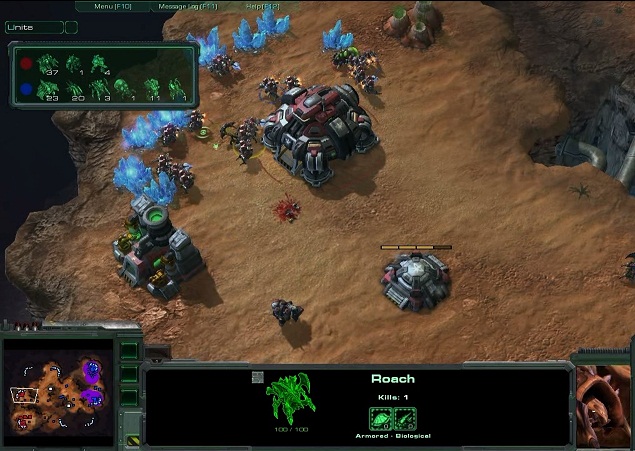
Reaper - a very nice addition, all in all they are the more mobile and universal version of the marine as they can jump on and off cliffs. Has 60hp and can plant mines as a special attack feature, although it wasn’t demonstrated in the report.
Marauder – this is a very interesting unit; I personally cannot label it a replacement for anything. It’s a walking unit with a longer attack range, shooting rockets or projectiles, sort of a half marine half goliath only with ground to ground rockets, looks similar to Vikings, but probably can’t transform to a gunship, has 125hp.
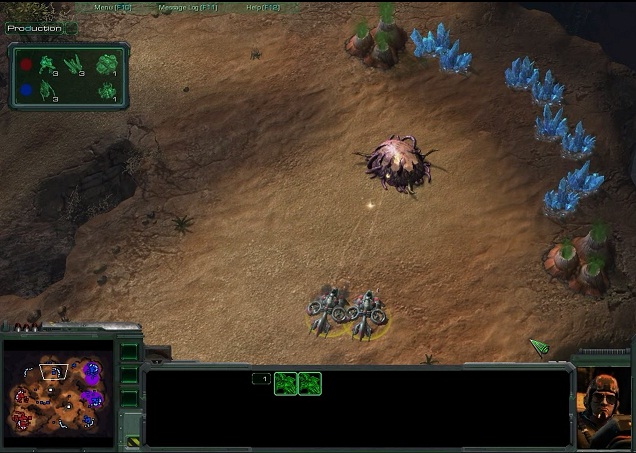
Banshee – This is a unit we will mention again in this article, but for now let’s focus on its stats and purpose. For the first time in Starcraft Terran has an easy accessible air unit that does solid damage to ground targets, it’s also armed with rockets and by the looks of it is very damage effective, defense-wise it’s quite good – 140hp for the first tier air unit, also has the “stealth” ability. The really good part is that two banshees can destroy the mutating Zerg Hatchery in 4 attacks each, or kill hydra in 2 attacks each, that’s damn impressive.
Nighthawk – To say its interesting would be a big understatement, it’s just mind shifting. A flying Terran support unit, that, although is pretty vulnerable, - 140hp, opens up two very useful abilities, - Auto-Turret (places a small 125hp attack turret on the ground, and Hunter-Seeker Missile a very slow moving missile, which more looks like a bomb, that follows the target even if one tries to move away or burrow, needless to say it deal a lot of AOE damage (enough to one shot Hydra and a Roach).
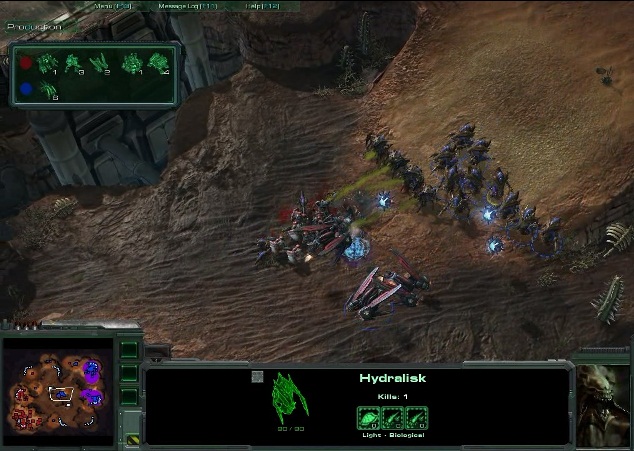
If you followed Starcraft II you might notice that the Auto-Turret ability was taken out from the Nomad, another kind of flying Terran special unit, which was a constructor and a detector, i.e. too much of a pie on one plate.
All this high tech pie makes up for a very mobile and powerful anti ground army, something Terran has been lacking since day one. Design-wise everything looks just about perfect, on this we end the Terran unit analysis, but we will come back to it discussing game mechanics.
From the Zerg we have: Drones, Overlords, Queen, Zerglings, Banelings, Roaches, Hydras and the Infester.
Right off the bat we notice that the Zerg by default has a bigger unit variety, even without going to higher tier units, but more on that later.
As usual we leave Drones and Zerglings out of the discussion as the most basic units.
Baneling – a Zergling mutation that allows him to become a walking acid bomb of sort. Deals enough damage to blow up a marine, probably even more, as well as splash AOE. Design-wise I like the new design, which simply is a walking mutated Zergling with green acid tank better than the old rolling wheel one, more on that later.
There was a very interesting moment in the first half of the game, Zerg attempted to flank Terran army with several Banelings, at the same time Zerg ran on a couple of Reaper mines, of as a result of that almost all of the units on both side were destroyed, by here’s a picture:
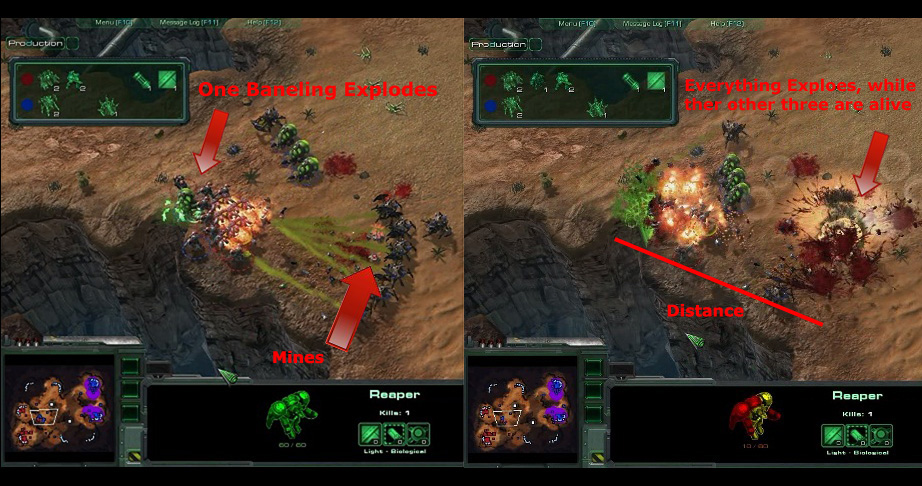
Queen – A Somewhat controversial unit, has ground and air attacks and a number of special abilities, has 175hp and deals an estimated of 10 anti-air damage. I can’t really comment on this unit until we have a complete list of it’s abilities and stats, for now it looks like having it is very beneficial for Zerg in both attack and defense aspects, therefore I deduce the unit is about to stay.
Roach – A very tricky unit to discuss, combines the powers of Zergling and hydra, making it a mobile long range attacker, probably without anti-air attack, still is very effective, deals five points of damage just like the Zergling.
Hydra – “Hello, old friend, how have you been?” I want to ask, - it looks like Hydra, although it still resembles every single old sketch of a deadly unit did undergo certain modifications, first of which is a different attack for air units, now it’s throwing white spikes out of its head. Damage and mobility wise it looks pretty much the same as before, has 90hp and deals an estimated 10 anti air damage per spike thrown (totaling to 16 per spike against Banshees), movement speed upgrade is also available.
Infester – A pretty small unit which can spawn several Infected Terrans, not much know about this combo except that Infected Terrans have anti air attack.
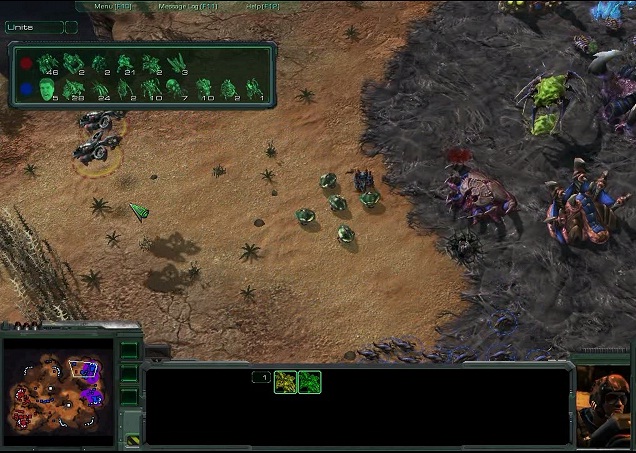
Overlord – An old time favorite of course, but now it can dispense certain amount of Zerg creep on the ground, that actually has been used in the game and has a lot of “caché” tactical movies implied.
It looks like we covered every unit that was used in the Battle report game; now let’s move on to Buildings.
Buildings
Terran: Command Center, Barracks with Tech Lab add-on, Merc Compound, Supply Depot, Bunker, Turret, Starport with add-ons.
Most of these buildings haven’t changed, so very quickly we’ll run through the new stuff only.
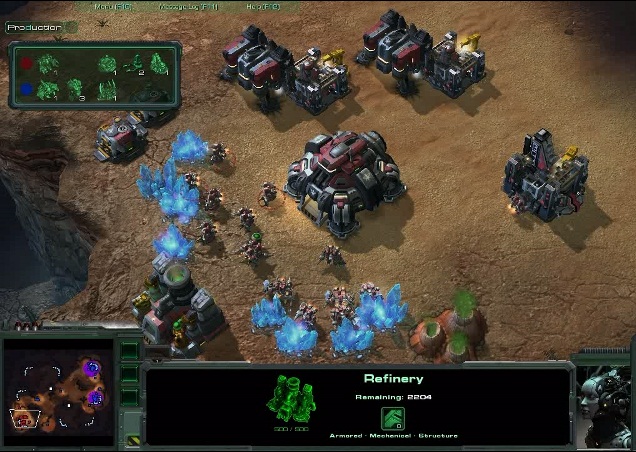
Tech Lab – an add-on to the barracks speeds up the production and opens new production options.
Merc Compound – A whole new building that allows producing Reapers and opens up certain upgrades for marines.
Bunker – hasn’t changed much, 400hp, still fits four units, and by the looks of it is still pretty useful.
Supply Depot – Still serves the same purpose but had its design changed drastically and I’d like to notice for the better.
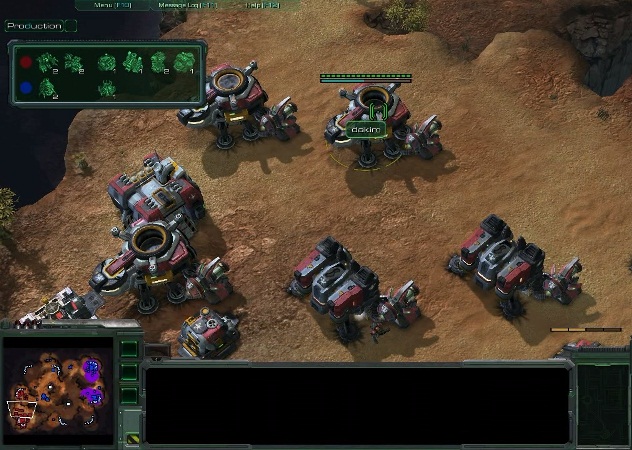
Starport – Same as before but this time packed with whole other number of production units: Viking, Banshee, Drop Ship, Nighthawk and Battle Cruiser.
Zerg: Hatchery, Spawning Pool, Queen’s nest, Spine Crawler, Hydralisk Den, Roach Warren.
Not much stuff to report here, only that Queen’s nest allows spawning of the Queen, Roach Warren – Roaches, and Spine Crawler is a new Sunken Colony, which can burrow out and slowly move around.
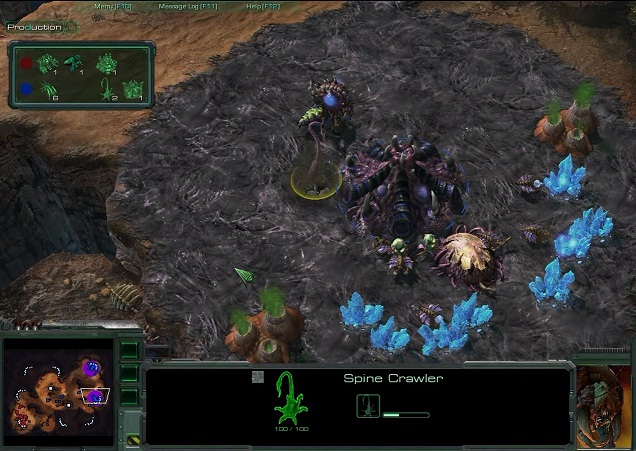
While talking about buildings we can’t not mention the Xel’Naga Tower, a neutral building that falls in control of any player if a unit stands next to it, it takes a few seconds to activate and works as a detector.
Design and Animation
Let’s examine the looks, animations and how they reflect on the gameplay and we are going to kick off with gathering minerals. If you pay close attention to both Zerg and Terran bases, workers exchange one another at the mineral patch almost instantaneously, bring minerals back to the main building and sail on the way back to the minerals very smoothly, and, as the actual resource gathering animation kicks off juts milliseconds before the unit touches the minerals. Not only that’s a sign of great work by animation artists at Blizzard, but also a clear indication of smoothness that was missing from Starcraft.
Also pay attention to the mineral patches, every time a worker starts mining it’s glowing, this way even without knowing the exact number of workers, a player with a well placed scout revealing enemy minerals only, can determine the velocity and therefore a strategy of his opponent.
Another very important part of the animation is the building process. For the Terrans it’s very detailed, each building from the bunker to barracks add-on has a different sized construction site, let alone as the building is raising player can notice a number of different building stages and therefore deduce the timing, strategic value and purpose of the constructing building.
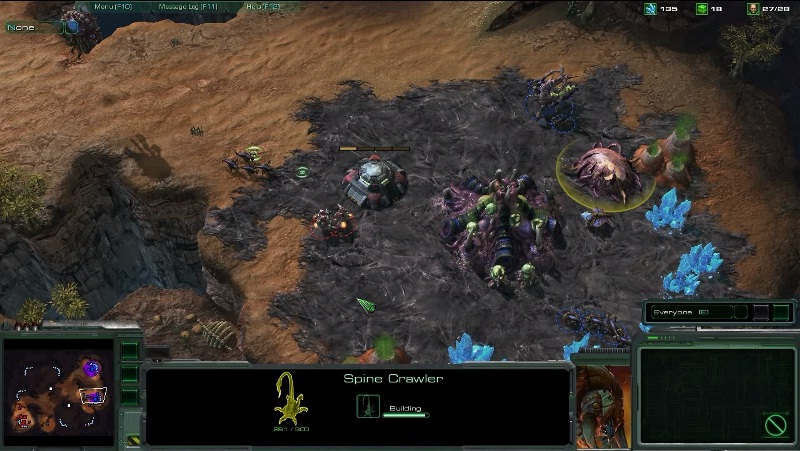
For the Zerg there is not much variety, even the Spawning Pool and the Hatchery are mutating from the same sized sort of biological cockpit, which looks very cool btw, but because it’s exactly the same for a number of buildings it could be very difficult to identify the building during mutation stage, - once again adds to the strategic aspect, this time scouting.
You probably noticed that even though Terran SCV was pulled away from building a bunker near Zerg’s natural, the animation didn’t stop.
What is the most important aspect of unit’s looks? Any player should be able to determine unit’s characteristics, from attack type and possible abilities to battle toughness just based on how any particular unit looks.
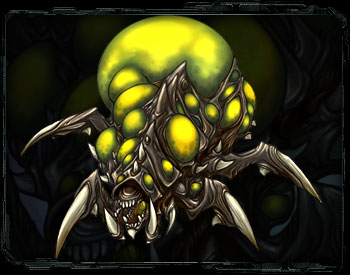
As an example let’s take the Baneling, in this build it looks like a Zergling with a tank on acid on its back, making it logical to expect it to blow up in a great matter, now the previous design, a spinning wheel, although looked scarier and somewhat more “Zerg’ish dreadful” didn’t have this intuitive feature.
In this area Blizzard did an incredible job, just take a look. Reapers have a Jet Pack and very visible burning flames coming out of it, Hidras sort of pulls it’s head in a little bit before spikes appear and it attacks an air unit, anything is very intuitive, you can tell right off the bat that The Mule is a resource unit just by its industrial style design, and the Nighthawk’s slowly moving parts indicate that there’s some sort of a special attack involving a slowly spinning object – in this case a Hunter Seeker Rocket.
All in all the death animation has been reduced to a minimum, - just a quick splash of blood and unit parts, remains disappear after 5 seconds, while blood and acid stains take about 30. Exactly the same counts for buildings as well.
Moving on to the most controversial issue of them all – similarities with Command and Conquer Games.
By now you probably know that Dustin Browder the lead designer of Starcraft II used to create CnC games, so what is it that we players find “not entirely unique”?
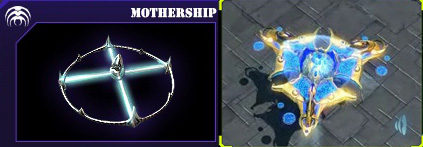
First – The Mothership. It’s yet unknown if the unit will make it to the final version of the game, however you don’t need an eagle eye to notice similarities to Alien Mothership from CnC. They are based over the same circle structure with crossing lines inside with a core in the middle, although Blizzard’s is much more beautiful, both possess a number of deadly super attacks and are therefore labeled “The Ultimate Unit”.
However it was announced by Blizzard that they came up with the Mothership unit before the Command and Conquer: Tiberium Wars was even announced, therefore we may count as a common idea or perhaps something they took from Herbert Well’s book, who knows.
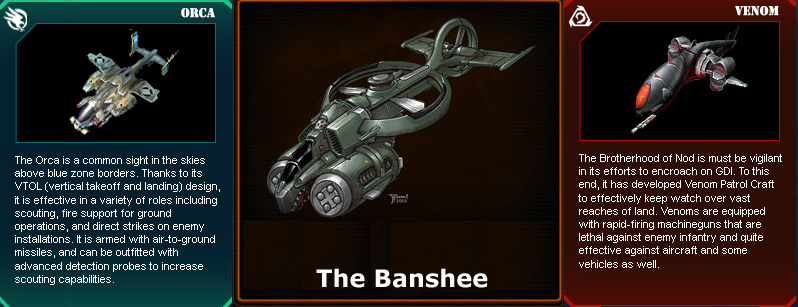
The next one is much more controversial one – The Banshee. An air unit that’s capable of inflicting serious damage to ground targets with rockets or some sort of white projectiles that sounds just too familiar. Little did you know the Nod and the GDI from the CnC have first tier air units too – the Venom and Orca, now let’s just take a look here and leave game decisions to Blizzard:
On this note we end the 2nd part of our Analysis, don’t forget to check in tomorrow for the third and final part, where we will be talking about Micro, Macro, Strategies and how all of that evolved from Starcraft to Starcraft II.

